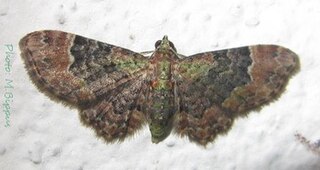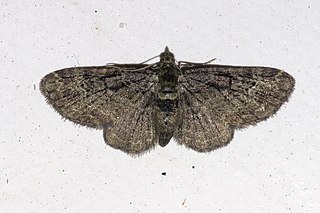
Lepidoptera is an order of insects that includes butterflies and moths. About 180,000 species of the Lepidoptera have been described, representing ten percent of the total described species of living organisms, and placed in 126 families and 46 superfamilies. It is one of the most widespread and widely recognizable insect orders in the world. The Lepidoptera show many variations of the basic body structure that have evolved to gain advantages in lifestyle and distribution. Recent estimates suggest the order may have more species than earlier thought, and is among the four most species-rich orders, along with the Hymenoptera, Diptera, and Coleoptera.

Moths are a group of insects that includes all members of the order Lepidoptera that are not butterflies. They were previously classified as suborder Heterocera, but the group is paraphyletic with respect to butterflies and neither subordinate taxa are used in modern classifications. Moths make up the vast majority of the order. There are thought to be approximately 160,000 species of moth, many of which have yet to be described. Most species of moth are nocturnal, although there are also crepuscular and diurnal species.

Pasiphilodes testulata, the pome looper, is a moth of the family Geometridae. The species was first described by Achille Guenée in 1857. It is found in Tasmania and on Norfolk Island, as well as in New Zealand and on the Chatham Islands and Kermadec Islands.

Chloroclystis is a genus of moths in the family Geometridae first described by Jacob Hübner in 1825.

Pasiphila is a genus of moths in the family Geometridae. As of 2005 about 36 species were known, and of these, some 27 are native to New Zealand.

Pasiphilodes is a genus of moths in the family Geometridae first described by Warren in 1895.

Eupitheciini is a tribe of geometer moths under subfamily Larentiinae, often referred to as pugs. The tribe was described by Tutt in 1896.
Pasiphilodes subtrita is a moth in the family Geometridae. It is found on the Marshall Islands, Woodlark Island, Tahiti, in Tonga and on Fiji, Rotuma, Samoa, Borneo, the Andamans, the Cocos-Keeling Islands, the Seychelles and Aldabra.
Pasiphilodes nina is a moth in the family Geometridae. It is found on Fiji.
Pasiphilodes viridescens is a moth in the family Geometridae. It is found in Malaysia, New Guinea and possibly Borneo.
Pasiphilodes regularis is a moth in the family Geometridae. It is found on Peninsular Malaysia.
Pasiphilodes diaboeta is a moth in the family Geometridae. It is endemic to Seram.
Pasiphilodes diaschista is a moth in the family Geometridae. It is endemic to New Guinea.
Pasiphilodes isophrica is a moth in the family Geometridae. It is found on New Guinea.
Pasiphilodes chlorocampsis is a moth in the family Geometridae. It is found on Peninsular Malaysia and Borneo. The habitat consists of mountainous areas.
Pasiphilodes fractiscripta is a moth in the family Geometridae. It is found on Luzon.
Pasiphilodes luteata is a moth in the family Geometridae. It is found on Borneo.
Pasiphilodes eurystalides is a moth in the family Geometridae. It is found on Borneo.
Pasiphilodes rufogrisea is a moth in the family Geometridae. It is found on Borneo.
Rhinoprora oribates is a moth in the family Geometridae. It is found on Java.





